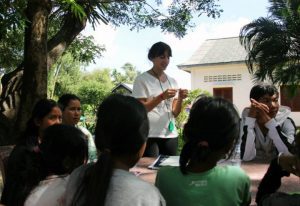In partnership with the PLF, a group of seven students from the Eugene Lang College at the New School in NYC spent five weeks conducting various innovative projects at PLF sponsored schools. Below is a letter to a prospective volunteer regarding a science project, carried out by Christina Hiras.
Dear Perspective Volunteer,
The process of preparing for the science labs was quite simple: think about what the kids already know versus what they need to know in understanding how labs work (Cambodian schools do not have science labs or hands-on activities in the classroom) and then create lesson plans that are fun and engaging. PLF told me they needed chemistry experiments conducted.
Being the novice scientist I am, I knew this could not be taught without understanding why scientists do experiments in the first place. So, my plan of action was as follows: 1a) scientific method, what it is and why it is useful 1b) observation lab 2a) chemistry overview, what it is and why it is useful 2b) chemistry lab 3a) biology overview, what it is and why it is  useful 3b) biology lab. Because there are no science labs in Cambodian schools, there is no equipment. I donated all of the supplies I needed and then some to kick off the program. There is a wonderful microscope I bought on Amazon for a very reasonable price. If you are interested in being a science volunteer, please, do not come empty handed. I suggest investing in a microscope with at least 400X zoom, dual lighting is nice but not necessary (the one I bought has it; 60 US$ from Amazon. Below is an inventory of PLF’s mobile science lab). Overall, this project is about giving students a new lens into which they can view the world and to me, the monetary value attached to it is something very incomparable and frankly benign.
useful 3b) biology lab. Because there are no science labs in Cambodian schools, there is no equipment. I donated all of the supplies I needed and then some to kick off the program. There is a wonderful microscope I bought on Amazon for a very reasonable price. If you are interested in being a science volunteer, please, do not come empty handed. I suggest investing in a microscope with at least 400X zoom, dual lighting is nice but not necessary (the one I bought has it; 60 US$ from Amazon. Below is an inventory of PLF’s mobile science lab). Overall, this project is about giving students a new lens into which they can view the world and to me, the monetary value attached to it is something very incomparable and frankly benign.
No ideas were forced onto the students. In fact, much of the preliminary planning was invalid by the time we had our first science meeting. What really ended up happening was conversation between me and the students all in an attempt to see what level they were at and what they wanted to get out of me “teaching” science. We learned about the scientific  method and that observations and questions are exceedingly powerful tools in everyday life, not just in a scientist’s world. Trusting the students to make the most out of our short moments together was very important in terms of not wasting anybody’s time, and the students seemed to respond tenfold to that approach. It is key to remember that as a volunteer, you are entering their world, so their rules apply. If there is one thing I need to say to end my leg of PLF’s science program, it would be that there are never too many questions. In the lessons we covered (scientific method, chemistry, and biology), I could see the students were continuously thinking outside of the box, and that, to me, is a success.
method and that observations and questions are exceedingly powerful tools in everyday life, not just in a scientist’s world. Trusting the students to make the most out of our short moments together was very important in terms of not wasting anybody’s time, and the students seemed to respond tenfold to that approach. It is key to remember that as a volunteer, you are entering their world, so their rules apply. If there is one thing I need to say to end my leg of PLF’s science program, it would be that there are never too many questions. In the lessons we covered (scientific method, chemistry, and biology), I could see the students were continuously thinking outside of the box, and that, to me, is a success.
by Christina Hiras
Science Lab Inventory:
1 Microscope
Approx. 100 blank slides and slide covers (no adhesive to create permanent slides)
Approx. 16 premade slides of natural and synthetic elements
2 400 ml beakers
2 100 ml beakers
Check out the Amazon wishlist for microscopes and slides.
And, to further promote science in rural schools, please make a donation.


Recent Comments